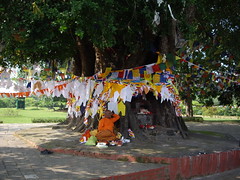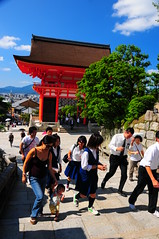 The journey to nirvana is as the growth of the sacred Bodhi tree in Buddhism. Like the expanding of the sacred Mandala, the spreading of Buddhism throughout the world is a dilation of this sacred location. Temples realized the spread of Buddhism from Korea into Japan, mainly through political initiatives. This began with the Soga clan’s temple at Asukadera, built to secure the nation. As this politically and socially adaptive religion spread, Buddhist architecture reflected the global spread of social, political, and technological advances. Building technology, culture, and monarchy spread with these temples. Buddhism’s growth and effect on the world can be referenced from its architecture.
The journey to nirvana is as the growth of the sacred Bodhi tree in Buddhism. Like the expanding of the sacred Mandala, the spreading of Buddhism throughout the world is a dilation of this sacred location. Temples realized the spread of Buddhism from Korea into Japan, mainly through political initiatives. This began with the Soga clan’s temple at Asukadera, built to secure the nation. As this politically and socially adaptive religion spread, Buddhist architecture reflected the global spread of social, political, and technological advances. Building technology, culture, and monarchy spread with these temples. Buddhism’s growth and effect on the world can be referenced from its architecture.Bodhi tree
The beginning point of the Buddhist religion is the Bodhi tree at the Mahadobhi temple in Bodh Gayais. Here Buddhah is said to have received enlightenment by becoming perfectly self-aware and no longer ego-centered. He taught that the purpose of life is to uncover this enlightenment rather than trying to attain it.
"Good sons, it is like smelting gold ore. The gold does not come into being because of smelting ... Even though it passes through endless time, the nature of the gold is never corrupted. It is wrong to say that it is not originally perfect. The Perfect Enlightenment of the Tathagata [Buddha] is also like this." [1]
Emulation of the Buddha meant searching for and realizing four noble truths: suffering, the origin of suffering, the cessation of suffering, and the way leading to the cessation of suffering [1]. Buddhism thus sought to end suffering by searching and refining rather than creating, ultimately to defeat the ego. For the followers of Buddha, awakening and becoming aware of the universe started with the sacred Bodhi tree. The universe was mapped with four corners, representing the four noble truths of Paramaitas, and the Bodhi tree was in the center.
This region of India is known as Magadha, meaning “holding that which became the center.”[2] The Buddhist pilgrimage focused on four locations, beginning with Mahadobhi. “This spot is marked by a stone seat, the varasana or ‘diamond seat,’ beneath the tree which represents the very center of the universe according to Buddhist cosmology.”[2] The nearby Mahabodhi temple is rectangular to further symbolize the four noble truths as points of orientation to the Bodhi. Pilgrimage to the sacred site was encouraged in Buddhism “as an assured method of lay devotees acquiring sufficient merit to ascend to one of the Buddhist heavens, or assist a monk on the path to nirvana.”[2]
A blue-print of this process can be seen in the mandala. The Mandala is a sacred art, consisting of concentric circles that represent the “container of essence.” The circle represents the “wholeness of the self.”[3]
 As a representation of the universe, the Mandala can be compared to the temple. Like the spread of temples, it is constructed from the center outward to four corners. Like the five-towered temple, “within the square palace or temple are images of deities, which are usually the Five Dyani Buddhas (the Great Buddhas of Wisdom).”[3]) It is a guide to the essence of reality, an instrument of connecting physical reality to spirituality. The mandala utilizes ever-present archetypes in an “individuation process- which is [a] version of the phychoanalytic procedure and a growth toward mental and emotional wholeness.”[4]
As a representation of the universe, the Mandala can be compared to the temple. Like the spread of temples, it is constructed from the center outward to four corners. Like the five-towered temple, “within the square palace or temple are images of deities, which are usually the Five Dyani Buddhas (the Great Buddhas of Wisdom).”[3]) It is a guide to the essence of reality, an instrument of connecting physical reality to spirituality. The mandala utilizes ever-present archetypes in an “individuation process- which is [a] version of the phychoanalytic procedure and a growth toward mental and emotional wholeness.”[4]Buddhism concentrated on the Bodhi in a collective synthesis of the phyche that sought unity across the land, realized by the spread of its architecture.
The Mahadobhi was a model of the essential elements of the temple that would be emulated through-out the world. Later temples in India and beyond were also rectangular in form, contained towers with amalaka finials, statuesque bodhisallva figures flanking and guarding the entrance, and similar ornamentation.[5]
This is because pilgrims to Mahadobhi brought back with them miniature statue shrines of forms of the temple. The five-towered mandala and the stupa can be seen across Asia because of these widely distributed sutras.[2] Mahadobhi thus became the first of the many remarkably similar temples that spread throughout the continent. The pilgrimage and sharing of values made India “a continuous religious space. With the spread of Indian religious practice- particularly Buddhism- beyond the subcontinent, this space was extended further.”[2]
Hinduism and other influences
Buddhism, and its architecture, is remarkable in its ability to change and adapt after its completion. The Bodhi tree is a fig tree, called ‘Ashwattha,’ meaning “One which does not remain the same tomorrow.”[6] Buddhists saw constant change as an essential definition of the universe and a vehicle for progress. The Mahadobhi endured centuries of radical changes as it went through phases of neglect, control under other religions, and rebuilding. Most notably, Hinduism intermingled with Buddhism and its architecture. “This absorption of the Buddha into the Hindu pantheon marked a historic shift from ancient Hindu polemics that cast the Buddha into the roles of fraudulent ascetic and heretic.”[5] Japan’s first Buddhist temple, at Asukadera, saw drastic change over time. Originally, a great temple two hundred meters long was built into three halls clustered around the pagoda.[7] Today, there are no ruins of the temple remaining. A few relics are all that survived the burned down temple. Rebuilt pagodas and temples stand there as testament of the resurgent victory of Buddhism.
Asukadera was constructed so that the Soga clan- one of many clans on the island- could gain the heart of the people and unite them politically, socially, and culturally. The first temple was built some time in the sixth century when the Soga embraced the new religion from Korea after the emperor had rejected it in favor of the religion they already had. The Mononobe clan warred with the Soga over religion until their defeat in 587AD. It was then the pagoda was built.[8] The “Asuka Temple became a symbol of the power of Soga no Umako, a position of influence that he later transferred to his son Emishi and grandson Iruka.”[9]
Umako’s tomb was added to the complex. The Soga clan fell in 645 AD from a coup. The coup occupied the Asuka temple and it was burned down. Asuka was remembered as a spring-board for Buddhism in Japan, though it was really a means for unification and establishing a ruler’s might.[9]
As Japan became further unified, Buddhism’s political role in Japan increased. The Buddhist temples were established as reflections of China's bureaucratic institutions.
 Korea was another influence on Japan from the Buddhist temple. Korean technological influence is “evidenced in the layout of the buildings and connecting passageways, and even in the designs of the roof tiles.”[10] Indeed, Japan didn’t build with roof tiles until the introduction of Korean religious architecture. The temple’s construction “was directed by immigrant clans… and involved the participation of artisans, skilled in temple carpentry, metalworking, tiled manufacture and painting, who were sent from Paekche along with Buddhist priests in 588.”[10] Smaller powers rallied under the Soga as “the work of temple building… symbolized the authority of those clans linked with the Soga-led government and was epitomized by the construction of Asukadera.”[3] Assimilation of foreign immigrants, technology, and culture largely became the base for the society. Buddhism was so successful across the East because it could be used by the leaders for political gain, its ability to structure and improve society, and its malleability with other religious ideologies.
Korea was another influence on Japan from the Buddhist temple. Korean technological influence is “evidenced in the layout of the buildings and connecting passageways, and even in the designs of the roof tiles.”[10] Indeed, Japan didn’t build with roof tiles until the introduction of Korean religious architecture. The temple’s construction “was directed by immigrant clans… and involved the participation of artisans, skilled in temple carpentry, metalworking, tiled manufacture and painting, who were sent from Paekche along with Buddhist priests in 588.”[10] Smaller powers rallied under the Soga as “the work of temple building… symbolized the authority of those clans linked with the Soga-led government and was epitomized by the construction of Asukadera.”[3] Assimilation of foreign immigrants, technology, and culture largely became the base for the society. Buddhism was so successful across the East because it could be used by the leaders for political gain, its ability to structure and improve society, and its malleability with other religious ideologies.The Buddhist temple provided an extension of the sacred center of the universe, the bodhi tree. As the mandala which extends unified concentrated space, the spread of temples across the land connected the spiritual with physical reality for societies. Collectively, temples sought to unify mankind, as places for changing perspective so the truth can be learned and one can refining the self. Extension to the far away land of Japan was achieved through political compatibility and the ability to structure and improve societies, and shows the architecture’s success in its religious motivations. It should be noted, however, that both Mahadobhi and Asukadera were razed, for unification of societies and mankind is as the Buddhist cycle of a man- it grows, dies, and rebirths.
[Images by:
^krebsmaus07- flickr/cc license
^Wonderlane^- flickr/cc license
^mitch59^- flickr/cc license]
Sources:
JSTOR www.jstor.org 10/24/2006
http://www.religionfacts.com
JSTOR www.jstor.org 10/24/2006
Mayumi. Pagoda. 12 March 2002. 19/24/2006 www.geocities.com/mayuagqui2
http://www.xs4all.nl
Tidak ada komentar:
Posting Komentar